In the last decade, social media has grown from a way for friends and acquaintances around the world to keep in touch to an essential function for brands of all shapes and sizes.
Whether you’re a single team member telling the story of a well-established company, a member of a multidepartmental marketing team, or you’re promoting your personal brand, having a well-established social media presence is one of the best ways to engage with existing and potential users.
Nearly 75 percent of U.S. adults actively use social media. A whopping 84 percent of adults 18–29 are active on social media. Bottom line — there’s an incredible amount of opportunity to reach people. But managing your social media presence requires a clear strategy.
A calendar helps you manage your brand’s social media presence the same way it helps you manage any other project — by creating structure, providing ways to keep stakeholders accountable, and enabling improvement over time.
By combining the right social media marketing strategy with the right social media tools, you can go from posting when the mood strikes to posting like a brand-building powerhouse.
What is a social media calendar?
The individual words that make up the term social media calendar make it seem a bit simpler than it is. Sure, your posts are listed with dates and times, but an effective social media calendar also helps you balance posting across multiple channels, enables you to better visualize your content strategy, and provides the foundation for a successful social marketing plan.
Why do social media calendars matter?
Your social media accounts are the backbone of your public brand presence, and you should treat them with as much care as any other facet of your marketing plan. Planning long-term email campaigns or massive inbound content initiatives takes time. The same is true for social media campaigns.
Planning social media posts may be even more important because of the fast-moving nature of the medium. Without plans and goals, you can quickly fall behind. Reviewing and scheduling posts in advance helps prevent typo-riddled tweets and Instagram incidents that garner unwanted attention.
Planning for the unplanned
You can’t predict every trend that crops up in your feed, but you can build your calendar around major events, product launches, new content offerings, and other relevant industry news.
By starting with subjects you know you want to cover, you’ll be able to manage trending topics smoothly when they do pop up, rather than scrambling to restructure your entire plan at the last minute.
As you brainstorm, consider sifting through existing content in your industry. Putting ideas in your calendar, even if they aren’t quite fleshed out, provides a roadmap for your team to follow. This is especially valuable if you’re managing multiple social media accounts for an agency or working with a larger marketing team.
Is a social media calendar important for a successful social strategy?
Your social media calendar may not constitute the entirety of a social media strategy, but it’s an invaluable piece of a cohesive social media marketing plan. Your calendar supports other facets of your social media strategy, like your goals and content creation process. Here are some of the reasons a social media calendar is a core piece of an awesome social strategy.
It keeps you organized
A content calendar should be an all-in-one place for social media, not just dates and times. Rather than building folders within folders of Google Docs, ensure all of your content lives in your calendar.
By consolidating your social-related information into one tool, you can save yourself the time and hassle of juggling multiple accounts and links. With digital calendars, you can also set up notifications for upcoming dates, so you can give each post the attention it deserves before it becomes a last-minute, emergency project.
It helps you develop content consistently
One of your key roles as a marketer is to tell a clear, consistent story with a recognizable brand voice and style. Creating content on the fly doesn’t work. It not only causes inconsistencies in the voice and quality of your content, but it can also lead to inconsistencies in posting times. Posting regularly keeps your audience engaged and ensures that your brand remains top of mind. Using your calendar, you can easily plot out what you’re going to say and when.
One of the first steps you can take toward posting consistently is to add major holidays and other important dates to your calendar first. Federal holidays don’t change as frequently as your Twitter feed, and it’s fairly easy to come up with content to post on those days.
If certain holidays aren’t directly relevant to your brand, you can skip them, especially if you need time to focus on something more important. For example, if you’re planning an exciting new webinar that happens to fall on President’s Day, you can probably get away with keeping your sights on signups rather than diverting your followers toward a birthday party.
It helps you report on your progress
If telling the right story to the right people at the right time is the first part of being a great marketer, being able to show evidence of that is a close second.
Setting goals is a vital part of a solid marketing strategy. What’s the point of doing a ton of work if you don’t know why you’re doing it? Once you’ve set goals for your team, your calendar serves as a repository for your social media performance and helps demonstrate whether or not you’re meeting the goals you set.
The information stored in your calendar can be analyzed in detail and tell you if you need to shake things up or if your content is killing it.
It provides visibility to other stakeholders
Visibility is invaluable for collaboration. Including upcoming posts in your calendar makes it easy to share your master plan with coworkers and clients, and provides an added degree of transparency to your work. If your ideas exist only in your mind, articulating what you’re working on becomes much more difficult.
Additionally, your goals (or your clients’ goals) can change. A high-level overview of your calendar helps you identify where you can make adjustments that align with your new objectives.
How can you create your own social media calendar?
The sample calendar pictured above is but one example of dozens of templates that can kick-start your own social media calendar project. Templates provide an excellent jumping-off point for you to start mixing, matching, and customizing your perfect calendar tool.
Before you decide on a template to work with, it helps to determine what aspects of a social media calendar are most important to you. There are a wide variety of tools and platforms that offer differing degrees of customization. Let’s take a look at the three most common types of calendars your team might adopt and some of the more popular digital calendar solutions.
- Paper calendars
Paper calendars are handy for tracking your work and assignments, but they aren’t very flexible or particularly useful for large teams. They’re a great aid, but by themselves, they just don’t hold up for long-term social media management when all of your work lives and breathes online.
Try to limit paper calendars for to-do reminders — and keep in mind that one of the key benefits of using a calendar is consolidation. Your design team unfortunately won’t see that post-it you left on your desk with that awesome idea you had for a graphic, but a quick ping when you assign them a project will keep the production process moving smoothly.
- Spreadsheets
Spreadsheets digitize the calendar experience and enable you to easily share your content plan with other team members. Columns are customizable, and spreadsheets offer more depth and flexibility than paper sheets. If you’d like to sample a simple, CSV style calendar, check out this template from HubSpot.
Having multiple sheets in a single file means you can organize several concurrent calendars by platform or publication time. You can also use pivot tables and formulas to create handy analytics dashboards that are a single click away from your calendar.
The biggest flaw of spreadsheets, however, is their static nature. Sharing files can lead to team members having different versions of the same document, creating more problems than they’ve solved.
At the end of the day, using a spreadsheet as your calendar also takes some serious retrofitting to make it fit all of your needs. Spreadsheets are meant to help you track large sets of data, not dozens of moving parts that have to change regularly.
- Software as a Service (SaaS) platforms
Software as a Service platforms offer a diverse array of templates as well as remote access for every member of your team. Being able to seamlessly update your calendar and have those changes appear simultaneously for everyone means you can do all the work you need to without sending manual updates.
There are dozens of platforms and tools available on the market, each with strengths, weaknesses, and fun features. While they have some key differences, deciding which to use will largely come down to personal preference. Below are some of the most popular SaaS platforms that you can use for all of your social media content calendar needs along with templates for each to help you get started.
Airtable
Airtable may look like a spreadsheet on the surface, but as a dedicated “cloud collaboration system,” its easy-to-use tags, customizable dropdown menus, and pre-built customizable templates add up to a seamless, user-friendly experience.
Airtable’s base system provides a great way to organize multiple calendars in one place and even move content between them easily. Their interlinking structure also makes it easy to create connections between various tables and databases.
All of those influencers you’re working with? They can exist in their own database — along with all of their contact information — but you can still access their data in a few simple clicks.
Airtable is designed with creators in mind, and its API allows you to make extremely complex integrations if you know your way around. Here are a few examples.
You can view Airtable’s ready-to-go Social Media Calendar here. With a wide range of default views and styles, including lists, calendars, and moveable kanban cards plus extensive customizability, Airtable gives you the power to create a calendar that meets your needs quickly.
But there are drawbacks. Airtable’s free plan has a 1,200 record limit, and you can view only two weeks of revision history. If you plan on using the platform long term, you’ll likely need to add a budget line item.
Asana
Asana is primarily known as project management software. Thankfully for us, that project can be a social media calendar. Asana’s pre-built calendar template can help you get your team up and running quickly.
Beyond its template library, Asana also offers built-in reporting features like a handy Gannt chart to keep every member of your team accountable for their pieces of the content process. The default reports are designed to measure work progress, but they can be repurposed into performance analytics tools as well.
In addition, much like Airtable, Asana’s API and app integrations give you the power to build your ideal workspace.
Jotform Tables
Jotform Tables is designed to be a spreadsheet, a database, a data analytics tool, and a workflow management platform all in one. Our star offering may be the Form Builder, but Jotform Tables offers easily shareable, fully customizable views for you and your team to track all of your social needs.
With all of the power of Airtable’s interlinked databases and the power of Asana’s baked-in analytics tools, JotFrom Tables allows you to collect, organize, and manage your social presence in one place.
The best part about using Jotform Tables is that it works directly with our namesake forms. You won’t have to manually sort your posts or move column by column to build your calendar.
Using our Social Media Calendar template, you can tailor your calendar before you start. Jot your information down, field by field, and Jotform Tables will automatically build a new entry for you rather than forcing you to navigate through the page to find what you need.
Form integrations also allow companies to manage online payments, generate documents with Jotform’s PDF Editor, and expand tool sets using form widgets.
Google Sheets
The Google Suite has become an essential tool for real-time collaboration. Because of the suite’s ubiquity, Google Sheets integrates easily with tools your team is already familiar with.
This powerful spreadsheet alternative blends the data- and formula-focused features of spreadsheets with the accessibility of SaaS tools. Much like more traditional spreadsheets, pivot tables and formulas can be built into your Sheets directly.
Sheets offers powerful integrations with third-party applications like relgrowth’s Twitter Auto Poster. While the platform has near limitless potential, building extensive dashboards in Sheets requires some legwork.
Google Sheets is designed to be an open canvas that can meet any number of needs, but this openness also means that each user has to create and design that experience. Not everyone has the technical expertise or time to build their tools from scratch. There are templates available, but other SaaS platforms provide a more tailored experience.
CoSchedule
CoSchedule functions as both a social media calendar and an automated publishing tool. You can manage all of your social media channels and your blog in one place with easy, drag-and-drop, customizable blocks. You can even build messaging across multiple platforms stemming from a single piece of evergreen content, and CoSchedule can recommend optimal share times and dates for each post.
An important note — CoSchedule’s blog tools integrate with WordPress, so if you host your blog on another platform, you won’t have access to all of its features.
If your social media strategy plays a small role in a larger marketing plan for your team, CoSchedule also offers a full marketing suite to keep everyone together, on the same calendar, in the same place, and improve cross-departmental visibility even further.
There’s a free trial so you can get your calendar up and running quickly. The Marketing Calendar tier of the platform starts at $29 per month. For teams that want to consolidate scheduling and auto-publishing, this is a great place to start.
What information should be in a social media calendar?
Alright, you’re convinced. You’re ready to roll out the perfect calendar. You have times. You have dates. You have goals, and you’ve chosen a calendar tool. What else is there?
We’ve touched on a few ways you can use the calendar, but now we’ll dive into the details. Let’s explore what you should include in your ideal calendar, why that information is important, and how you can harness that information to be the best.
Columns
Title of the post
For your own sake, make the title as unique as possible to differentiate it from other content in your pipeline. When you brainstorm titles for articles and posts, consider your audience and what they’re interested in.
If your work is in a niche industry or you’re working with multiple brands, your content may overlap frequently. Targeted titles will keep your audiences prioritized and your calendar in order. Not every tweet or photo will have an article title attached to it, but if your social strategy involves multiple channels and media formats, this is a must-have.
If you’re struggling to come up with a catchy, unique title, here are a few tips to keep in mind.
Make sure it’s accurate
A fancy title that draws a reader in isn’t worth much if they don’t stick around. Someone engaging with your content should know what they’re getting into.
Keep it relevant
If you’ve already written the piece of content you’re sharing, then you’ve already done keyword research, and you know what your target audience is looking for. Using relevant industry key terms will catch a would-be reader’s eye.
Trim it down
Length is subjective, but aim to keep your titles under 70 characters. This ensures the full title will be visible in search engine results. If you want to test how your title will look before you share, try out this handy tool from Moz SEO.
Have fun with it
Accurate and succinct don’t have to mean boring. A little alliteration goes a long way. Verbs pop and empower readers to take action. You want your posts to feel genuine and as human as possible, so enjoy yourself.
Social media channel
Not all content is equal. Your in-depth product insights article might be a great piece for the LinkedIn crowd, but it could be a bit long for the average Twitter skimmer. Make sure you know where and why you’re sharing your content. This helps you to take stock of which channels you should focus on and which ones can take a backseat.
Say you’ve been posting three times a week on Twitter and LinkedIn. When you review the engagement numbers, you notice that your LinkedIn posts have gotten 10 times more engagement. Depending on your goals, you might want to change up your Twitter strategy or shift more of your focus toward the LinkedIn crowd.
We suggest using a Choose All That Apply style button or dropdown menu for this column in your calendar. That way you can track posts that are being shared on multiple channels. On the other hand, if your goal is to build your Instagram account or your intended audience only uses LinkedIn, you may not need this space.
Publish date and time
This is a calendar, after all. The date and time of publication are the bare minimum components of a well-planned calendar.
Beyond keeping you organized, tracking the date and time is invaluable for gaining deeper insights into your content performance. By documenting when you post alongside what you post, you can review historical data to understand what times of day and days of the week lead to higher engagement with your audience.
Reviewing these trends provides you the opportunity to better optimize content in the future and grow your engagement. If you want to learn more about how to take advantage of this data, check out the section below on analyzing your social media metrics.
Content category
If you have any experience maintaining blogs, you know how important categories can be. Having umbrella terms for major subjects that your social media posts are likely to cover provides insight into what kinds of content your audience is interested in seeing. Here are some tips for creating and using content categories to your advantage.
Limit your categories
Try to keep your category list fairly short. Build three or four content categories to start, and if your brand expands into new types of content, add a few more. These categories should be broad enough to cover topics relevant to your industry but not so broad that 80 percent of your content falls into a single bucket.
On the flip side, if a single post stands alone in its category, you can likely merge that category with an existing one.
Assign only one category to a post
Content categories should be mutually exclusive. Each time you plan a post, decide which category it belongs in. If you feel like a post belongs in multiple categories, you may need to reevaluate your breakdown.
Decide on a naming convention
Anyone should be able to sift through your categories and know exactly what content belongs where at a glance. A consistent naming convention helps you to maintain the exclusivity of your categories.
Let’s take a look at a list of categories for a chef’s Instagram account that could use a bit of cleanup:
- Appetizers
- Entrees
- Desserts
- Soups
The first three categories are sorted and distinct. Soups, however, is confusing. If the chef was preparing to schedule a post for a new soup recipe, it could fall into Appetizers or Entrees, depending on the dish. Removing that category eliminates potential overlap and improves accessibility to the information.
Target audience
Just like with any other type of content, you need to identify the buyer personas or target audiences for each post. You have to understand who you’re speaking to and what value you’re providing them. This is an important piece of your overall marketing plan, so be sure to work out these details with the rest of your team.
If your audiences are smaller, you may distinguish only between advertising to B2B and B2C targets. Larger teams may have a detailed breakdown of their perfect consumers in various verticals. Here are a couple of things to consider as you build the audiences in your social media calendar.
Consider where your users engage
We touched on this a bit when discussing social media channels, but it’s important to keep in mind where your target audiences spend their time. Before you start adding all of your audiences to this column, think about whether or not certain personas actively use social media.
Your marketing team as a whole may have half a dozen personas to focus on, but some of those may not actively use Twitter. Maybe some of your small business clients rely heavily on their Facebook pages but don’t use LinkedIn very often.
Scope out the competition
Do a little competitive research. Take a look at what competing companies are posting on social media and what audiences their messages are tailored to.
Think about what questions or problems those audiences have that only you are equipped to answer. You may find a key demographic for your new content and identify new audiences based on what content does and doesn’t already exist.
Status
A status field is a simple way to keep track of your current content pipeline. This field can be as simple as a Yes/No toggle that denotes whether or not a post is live or as complex as a list of the stages that make up your content creation pipeline. More complex teams may have more people involved in the content creation process. We’ve listed some sample statuses below.
Brainstorming
If you’re starting to plan for a new month or quarter, this is invaluable. Not every entry in your calendar will be finalized when it’s added.
Drafted/ready for edits
If there are multiple stages in your content review process before something goes live, this status indicates when a piece is ready for another set of eyes. Depending on your tools, you may be able to use this status in conjunction with your “Assigned to” column to trigger tasks.
Ready to post
Once a post has been approved and you have all of the relevant assets (additional attachments, links, etc.), you can mark it as ready to go and schedule it. This may seem duplicitous if it’s posted immediately, but it can be handy if, for example, a designer is handing work back to the account manager.
Scheduled
Your post has escaped planning purgatory and is ready for your audience. You’ve marked the date and time in your calendar and maybe even set it to post automatically using a handy management tool.
Live
Your post is now up and running. The content creation process is complete. Now it’s time to move onto monitoring and evaluation.
Archived
You might not want to outright delete your team’s posts from last year, but that doesn’t mean you need to see them every day. Having a separate status for posts older than a certain number of days, weeks, or months allows you to filter them out and focus on your current projects. Decide with your team how far back your current calendar view should go and filter out the stuff you don’t need.
Removed
You won’t often need to pull down old posts, but every once in a while you may need to delete posts with broken or outdated links to keep your feed clean.
Assigned to
If there are multiple people on your team, having a column that transparently states who the stakeholders are for each step of the project keeps everyone accountable. Some SaaS tools (a few of which are listed below) even provide Gannt charts so you can easily view a post’s journey through the content pipeline, track potential roadblocks, and identify folks who might need a little nudge.
Alternatively, rather than using the “Assigned to” column to refer to specific posts, you can assign specific team members as channel managers. This method of delegation means that interchannel brand voices may feel more distinct. While this may be what you’re going for, it can also harm your brand’s consistency if every team member isn’t on the same page. If you go this route, make sure to establish clear style guidelines to help compensate for the variation.
[Insert channel] caption
These columns help you organize the way the same post is presented across multiple channels. The length and style of your captions will vary from platform to platform. A tweet maxes out at 280 characters, but a LinkedIn status update can be up to 700. Try not to get carried away, though. Research conducted by HubSpot says the ideal length of a tweet is still 120 to 130 characters.
Your brand voice should remain consistent wherever you’re sharing content, but small changes to tone and presentation can make a big difference for distinct audiences. LinkedIn readers are looking for to-the-point, professional information, but your Instagram followers are likely closer to your brand and enjoy a friendlier, less formal style.
Call to action (CTA)
Don’t forget to toss in a call to action. This doesn’t always have to be a link or a downloadable asset. A CTA can be as simple as asking your followers a question to start a dialogue. Get in the habit of including a call to action in each of your posts, and watch those engagement numbers tick up.
Hashtags
Hashtags have several uses, including increasing engagement, creating an easy identifier for your content, and adding context to more niche posts. You can organize your hashtags in a table within your social media calendar so that you can easily refer back to them.
Saving hashtags can help you review the content and concepts you’ve posted about before, cluster similar topics, and — in combination with certain engagement metrics — help further shape the kind of content you want to produce.
Looking at how others are using the same hashtags can offer inspiration for your campaigns. There may be some overlap between this column and your “Category” column, but hashtags will quickly diversify as you start to roll out dedicated campaigns.
If you’re still in blogger mode, think about how you use categories together with tags on your blog. There shouldn’t be direct overlap, but tagged content clusters will start to form their content groups underneath your category umbrellas.
If you’re starting to incorporate hashtags into your content or you started working with a new client, it might be challenging to come up with hashtags out of thin air. RiteTag is a great tool that tracks and analyzes hashtag use for Twitter and Instagram, helps you identify trends in your industry, and shares which tags are overused.
Attachments
A majority of your social media posts should contain some sort of attachment. The most common attachment will be an image, whether it’s a 1200 x 628 image for a link shared on Facebook or a 1080 x 1080 Instagram photo. Some of your posts may include videos or come with downloadable assets like e-books, white papers, cheat sheets, or other tools.
Keeping these assets (or links to them) in your calendar alongside the posts themselves provides a record of how and when you shared each item. Combining this information with traffic data from Google Analytics helps you attribute downloads to particular channels and get a sense of which of your social media accounts can help the most.
Performance data
This column (or series of columns) is likely to evolve and expand over time as you determine which metrics are the most important to track. Reflect on your team’s overall marketing goals and your social media goals specifically. What metrics will you need to capture to measure the success of those goals? Simply tallying clicks, likes, shares, and comments might not be the right solution for everyone.
Once you decide what you’re tracking, figure out when to track it. Evaluating a post’s performance an hour after you share it will provide completely different data than if you check up on it the next day or at the end of the week.
Most social media analytics tools work in real time, so if you’re automating your performance tracking, you won’t need to make these decisions yourself.
Processing this data — either manually with spreadsheet pivot tables or built-in SaaS calendar features or automatically with social media analytics tools — allows you to visualize and analyze your work and improve over time.
Other
Every organization is different, and you might want to include more columns than those we’ve listed here. For example, if you work for an agency, you might consider including a “Client” column to denote who you’re posting for. If you’re maintaining all of your clients in a single calendar, you can review all of your work in aggregate or filter by client.
If you plan to collaborate with external content creators or social media influencers on guest posts, you may want to split “Assigned to” into internal and external stakeholder columns. Or if you have a bit of money behind your upcoming status updates, you can add a “Boosted” status to denote which pieces have some spend behind them. The possibilities are endless.
With so much opportunity at your fingertips and the hundreds of ideas that are probably now brewing in your mind, let’s get started building your social media calendar.
How to execute your social media strategy using your calendar
You’ve built a great social media calendar, and now it’s time to put it to work. Adding a few more tools to your content ecosystem can help you bring your social media game to the next level. Combining the right tools with a few tips for content creation will pave the way for you to power past the competition.
Tools
A plumber probably won’t finish a complex job with a single wrench. Likewise, a savvy social media marketer shouldn’t limit themselves to one tool. The following are a few types of tools that will complement your shiny new calendar.
Social media management tools
In addition to your calendar, consider using tools that help with posting, scheduling, and reviewing your posts before they go live. Your calendar may keep all of your ideas in one place for the long term, but management tools can be invaluable in creating a data-driven social media posting plan.
One of the strongest advantages is being able to schedule your posts to go live ahead of time. In combination with your calendar, this means you can potentially craft and schedule weeks’ worth of social content at a time, leaving you to focus on what comes next rather than working day to day to keep up. If something changes or sudden news needs to be covered, you can easily replace the scheduled post and move it to another day.
When you’re deciding which tools work best for you, keep in mind that you may need more than one. Some offer versatility for managing multiple accounts at once while others are hyper-focused on specific channels. Here are some of the pros and cons of the most popular management tools on the market.
Hootsuite
Hootsuite offers a powerful suite of tools that provide a complete, all-in-one approach to managing multiple social media platforms. Hootsuite pairs easily with Facebook, Instagram, Twitter, and just about any other social network.
You can also use it in tandem with your social media calendar by exporting your calendar as a CSV file and bulk uploading your posts to Hootsuite’s scheduling tool. This feature alone can save you hours of work, and if you’re super prepared, you can potentially schedule weeks’ to months’ worth of content with a single upload.
Hootsuite’s entry-level Professional tier starts at $49 per month and will cover most small teams’ requirements. Check out the pricing plans and what’s included in each.
Buffer
The first thing you’ll notice when you start scheduling with Buffer is the power of the Buffer queue. With the queue system, you can drag and drop posts to your customized times of day and days of the week, then let Buffer handle the rest. This feature is super helpful for short-term planning and allows you to move pieces around frequently with no hassle.
Buffer’s first subscription tier starts at $15 per month, but if you’re looking to add analytics, you’ll jump to $50 per month. Even for large enterprise teams though, Buffer is a budget-friendly option for a quick and simple publishing tool.
Loomly
Loomly takes automated social media posting to a new level. Not only does it help schedule new posts, but it can also help you create new content. By scouring RSS feeds, trending hashtags, and upcoming holidays, Loomly shares content recommendations to make sure you never run out of inspiration.
It also comes with some baked-in analytics and a content calendar feature if you’re interested in keeping all of your moving parts in one place. If you’re looking for a simple, multifunction solution for a small team, Loomly could be a great fit. Plans start at $25 per month.
Zoho Social
Another straightforward scheduling tool for the most frequently used social channels is Zoho Social. While its bells and whistles don’t outpace any of the other solutions here, it does shine as a low-cost entry for a big team or agency (pricing starts at $10 per month).
You can easily add extra team members to the management process, and built-in collaboration tools let you work along with your team in real time.
Additionally, Zoho’s agency tier packages enable you to manage up to 20 brands — with seven channels each — through one account. This makes it even easier to scale up as you grow.
SproutSocial
SproutSocial offers much of the same functionality as Buffer and Hootsuite with an integrated feed, easy scheduling features, and some straightforward analytics dashboards. Its Standard package starts at $99 per month, per user, which is a bit steeper than other platforms listed here, but there’s a reason SproutSocial is such a big name.
It prides itself on being a tool designed to foster meaningful, empathetic relationships with consumers, and it has served more than 25,000 brands. You can learn more about its offerings on the company website and decide for yourself if it’s worth the investment.
Regardless of which platform you go with, all five listed here — and many others — offer free trial periods. Make sure to test the waters and find the one that works best for you. If you’re looking for even deeper insight into which automation tool will work for you, check out our guide on the top 7 social media automation tools.
Social media engagement tools
Unless your entire business model is social media-based, building your brand and growing engagement on social media is only a small part of a larger marketing strategy. Every user will experience your brand in different ways — whether that’s through your website, your social channels, or a chat with your team. As a result, it’s important to give users a variety of ways to encounter and engage with your content.
There are several apps and plug-ins you can use to embed your social media feeds into your website. If you’re a WordPress user, plug-ins like Smashballoon allow you to customize how you present your feed through your site. Add-ons like this one from Ultimately Social also allow you to embed single-click signup buttons and draw some extra attention.
Social media signup forms
Continue to expand your social media channels’ role in your marketing strategy by making use of easily accessible signup forms. Easily embeddable forms like Jotform’s social media contact form make it easy to bring your Twitter followers over to your LinkedIn and even encourage direct product engagement.
Not everyone who sees your content is ready to commit, though. Social media is a powerful lead generation tool because it creates a more organic relationship between your business and your target demographics and nurtures that relationship over time.
Even if someone doesn’t sign up for a demo from your awesome Facebook post, providing an easy way for people to follow you on other channels or sign up for a newsletter from an existing social feed will keep them in your ecosystem for later.
Tips
Now that you’re armed with a marketing tech stack, let’s dust off your content creator cap and think about how we can get more eyes on your content.
4 tips for creating great social media content
No matter how extensively you use the tools at your disposal, it’s important to remember that social media is dynamic and changes constantly. Viral content can be picked up, circulated on every channel, broadcast on national television, and dead within a few days — only to be replaced by the next big video or meme.
Even with an expertly executed calendar to guide you and a tech stack equipped with all manner of widgets and automated tools, the best way to create an amazing content strategy is to create great content. Here are a few tips to create the right stuff for your audience.
Provide value
Think back to when you were deciding on target audiences and personas. We talked about creating content that interests them, but what does that mean?
When you start the content creation process, keep your audiences’ needs in mind. Your content should offer some unique value. This can be as simple as a witty quip to make them laugh or as in-depth as a downloadable white paper or guide.
Use multiple media formats
Did you know that social media posts with video content are viewed 48 percent more often than ones without video? As of February 2020, TikTok had amassed over 1 billion users. Video is everywhere. If you still aren’t convinced that multimedia posting is important, check out these 55 video marketing stats of 2020 from Biteable.
Pro Tip
Looking to make the most of your TikTok profile? Learn how to add a clickable link to your TikTok bio and drive traffic like a pro. Check out this guide: How to add a link to your TikTok bio.
Don’t forget to edit
You’ve built the calendar and drafted the posts. Everything is in place. Your first tweet goes live at 9:37 a.m. You misspelled your guest interviewee’s name, and there’s no edit button on Twitter.
We all make mistakes, but your calendar is here to support you and hopefully limit the need for a big red delete button. Double-check all of your content before you post it — or before you schedule it in advance if you’re getting good at this — to keep your brand’s rep up to snuff.
Collaborate with content creators
Collaboration can be an essential piece of the content creation process. If you’re struggling to populate your calendar with content by yourself, consider taking a look at tools like ClearVoice and Zerys that can get you in touch with vast networks of freelance content creators. Just because you can write an incredible e-book doesn’t mean you’re an Instagram wizard.
Your cocreators don’t have to be complete outsiders either. If you already have brand promoters sharing your content or showing off your products, work with them. Sharing user-generated content creates more opportunities for organic brand growth by emphasizing to others online that people like them love what you’re doing.
The best times to post on social media
In the world of social media, timing is everything. Post management and scheduling apps ease the process, but it’s still up to you and your team to determine the best times to post for your company. Ideal posting times will vary for any number of reasons, including channel, intended audience, and the content of the post itself.
On top of these factors, determining your posting sweet spot can be tough. If you post too frequently, people may stop paying attention. If you don’t post enough, they might move on to the next big thing.
The best long-term solution is to test and iterate. Your audience’s needs and interests will change over time, but we don’t want you to dive in blind. Before you start scheduling your new calendar, here are some general tips to keep in mind.
The first rule
If we had to choose one key piece of advice about posting times, it would be to post during the week for B2B audiences. Even if you have the power to schedule posts on the weekend, your posts are much more likely to find traction if you share them during the workweek. Some B2C companies will see high traction on the weekends, but high-level overviews of each platform show much better performance Monday through Friday.
Beyond this rule, think about which social media platform you’re posting to. Each platform has peak times. Again, these will vary from business to business, but each platform has general trends that can help you get started.
According to a study conducted by SproutSocial, the best way to engage with your fans on Facebook is to share near the middle of the day and the middle of the week. The site’s engagement metrics form a bell curve that ramps up from extremely light engagement at the beginning of the week and comes to a peak on Wednesday from 11 a.m. to 2 p.m. before descending again.
Thanks to the platform’s unique algorithm, posts aren’t shared chronologically. Users see content that Instagram believes they will enjoy based on their interests and how they use the platform.
While we recommend posting during the workweek and at traditional peak times — around noon for lunch breaks and 5 p.m. for after-work commutes — post times have less impact on whether or not your followers see your content than they do on other platforms.
LinkedIn has the luxury of being a social network with a more niche audience. The professional tilt of LinkedIn means that its users expect business and professional development-related content during business hours.
Traffic trends tend to climb in the mid-morning (8 a.m. to 10 a.m.) and early afternoon (1 p.m. to 2 p.m.) as folks are settling into their workspaces. Much like Facebook engagement, activity on LinkedIn tends to be higher in the middle of the week.
Twitter’s bite-sized content is prime commuting reading, so it’s no surprise that the best times to tweet tend to fall from 8 a.m. to 10 a.m. and 6 p.m. to 9 p.m.
According to HubSpot, people browse for business needs when they’re working (weekdays) and personal needs when they’re off work (weekends), so your ideal days of the week will vary depending on your target audience. Some B2C companies show higher engagement rates on weekends, while B2B teams reach their audiences on weekdays.
How to track and analyze your social media success
Even the most clever social posts don’t mean much if they don’t get proper exposure. Tracking data in your social media calendar can provide a high-level view of your social engagement and establish performance benchmarks.
If your team depends heavily on social media engagement as a channel for leads or brand awareness, you may also benefit from more complex social media analytics tools. Let’s take a look at a few ways you can track your social media post performance.
Using your calendar tool
As we mentioned in our column breakdown, you can add columns to your calendar to track important stats. Your click-through rate may be much more valuable to track than the number of comments you get. Maybe you’re running a top of the funnel awareness campaign and your views and likes are higher priority than the bottom of funnel conversation.
Your social media calendar is a flexible tool that allows you to track each of your relevant metrics as you see fit, but it’s limited when it comes to providing deep insights and can get messy if you add too many extraneous columns.
If you find yourself running out of room, you can set up a separate spreadsheet (or additional workspace or base) for performance tracking. That way you can leave notes for yourself on what went right — or wrong — for a particular post.
Another bit of data you should track long term is the number of followers you’ve gained or lost. This data point probably won’t change dramatically on a post-by-post basis, but keeping an eye on it is a great baseline for social wins.
If tracking all of this yourself starts to get out of hand, or you’ve grown to the point that you need expansive, real-time analytics and assistance with performance optimization, don’t fret. Dedicated social media analytics tools can track, manage, aggregate, and visualize your data sets for you. Sometimes it helps to leave the number crunching to the pros.
Using social media analytics tools
Tools like Hootsuite and SproutSocial can do more than schedule posts — they also offer deep insights into your social media performance over time.
By reviewing certain types of posts or campaigns, you can make more informed decisions to optimize your social media presence. Not only that, but you can also use the data to improve your internal processes and create a feedback loop that improves your social media calendar and overall social strategy.
If you see that posts with less text are performing better, focus on beefing up your upcoming content with more images and videos. If you find that posts with graphics are significantly outperforming ones with stock photos, you may need to loop a designer into your content creation process.
Knowing when to make these changes effectively is all but impossible without the data to back it up. Let’s check out a few of the best social media analytics tools available to your team so you can back up your gut feeling with cold, hard facts.
Top 5 social media analytics tools
Hootsuite
Hootsuite’s most potent offering is its host of in-depth analytics. With more than 250 parameters to measure, you can easily build a dashboard that aligns with your KPIs and measure what you need. And if you’re already using Hootsuite’s scheduling tools, you can limit the number of platforms that have to communicate with each other.
Hootsuite’s entry-level analytics tools are included with your scheduling subscription and are powerful in their own right. Additionally, the suite can scale with your marketing operation. Its enterprise solutions provide in-depth ROI reports and team productivity analytics to take your team to the next level. Hootsuite’s customizable reporting features start at the Team tier for $129 per month and scale from there.
SproutSocial
Sprout Social’s Professional and Advanced pricing tiers, starting at $149 per month, catapult it from post scheduling to a social media analytics juggernaut. Advanced analytics for both single and multi-channel strategies can be consolidated into versatile custom dashboards. Other social tools provide a holistic view of every layer of your social media strategy.
Sprout Social also incorporates another handy feature into its analytics tools — social media monitoring. With social media monitoring, you can easily track trends, topics, and keywords across your industry and all of your social networks.
You can even use this tool to discover new influencers in your space to make sure you’re caught up on the hottest news. With all of this data side by side with yours, you can make more informed decisions about how you want to tackle your next post or campaign.
BuzzSumo
While Sprout Social and Hootsuite are analytics tools at their core, BuzzSumo highlights social media monitoring as its primary value proposition. BuzzSumo enables users to “quickly discover content ideas, uncover platform insights, identify passionate influencers, and more.” BuzzSumo tracks mentions of your brand; mentions of competing brands; and shares, backlinks, and general engagement with your posts.
What BuzzSumo lacks in hyper-specific analytics for your team, it makes up for with industry-wide data that works in concert with other social media tools. If you’re looking to better understand key market trends to fill your social media calendar or collaborate with influencers to increase brand awareness or engagement, BuzzSumo shows you what will and won’t work before you commit.
Pricing for BuzzSumo starts at $99 per month, but the company offers a free trial as well as a free plan so you can see what it can do for you before you leap in.
Keyhole
Keyhole prides itself on being an analytics powerhouse. And although it doesn’t cover all of your analytics needs, it does provide a comprehensive way to analyze, evaluate, and strategize for Facebook, Twitter, and Instagram using hashtags.
Real-time analytics also give you key insights into the ideal posting times for your industry by tracking user activity and engagement by hashtag and topic. Another value add from Keyhole is the power to break down hashtag users and users who interact with your account by demographics, so you can create even more segmented content. Starting at $79 per month, Keyhole isn’t the cheapest tool on the list, but it offers a unique social lens.
HubSpot
HubSpot is a powerhouse in the marketing world, for better or worse. You can easily evaluate your social media performance using custom parameters and develop unique dashboards to directly compare your work both across and within individual channels.
The biggest benefit of HubSpot is also its biggest downside — size. It’s an all-in-one marketing tool and can integrate your social media analytics seamlessly with email, website, and blog engagement.
Due to its sheer scale, it doesn’t come cheap, and unless you’re looking for a new, dedicated marketing platform, the $800 per month price tag (for the Professional plan) might be tough to swallow.
Conclusion
You can’t plan the next big social media trend. That’s up to your audience to decide. What you can do is set yourself and your team up for success by building a strong infrastructure and a system that’s adaptable, flexible, and helps you meet your goals.
By combining a talented team with a well-organized calendar and a few additional tools, you can spend more time creating and strategizing and less time worrying about who was supposed to send out the Tuesday Tweet or post the #TBT to your Instagram feed.
In the right hands, your calendar can evolve from a notepad with dates and times hastily scribbled down to an analytics hub that easily shows off how awesome you are. So what are you waiting for? You have content to schedule!
Try the Jotform Tables social media calendar template today!






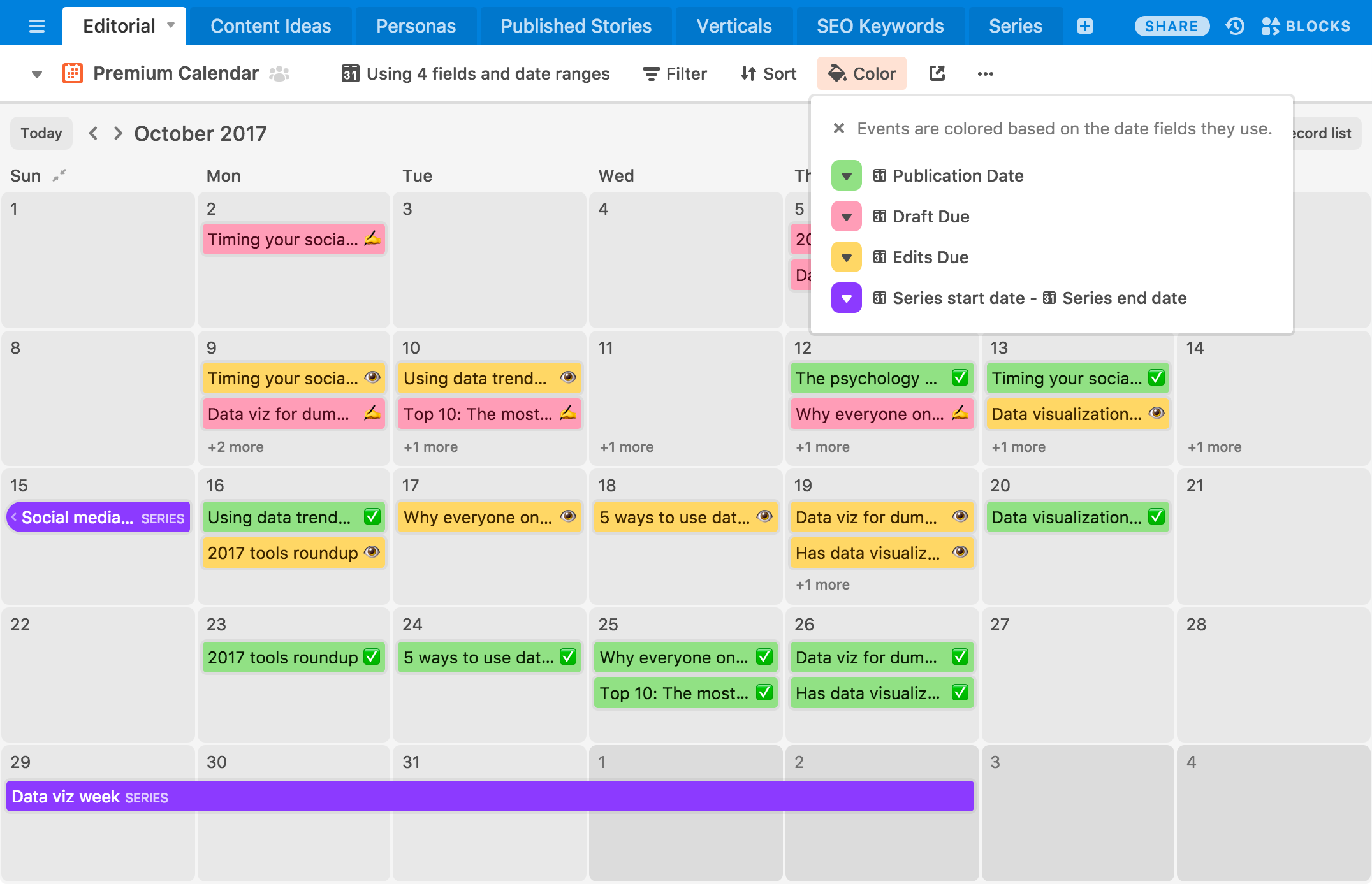

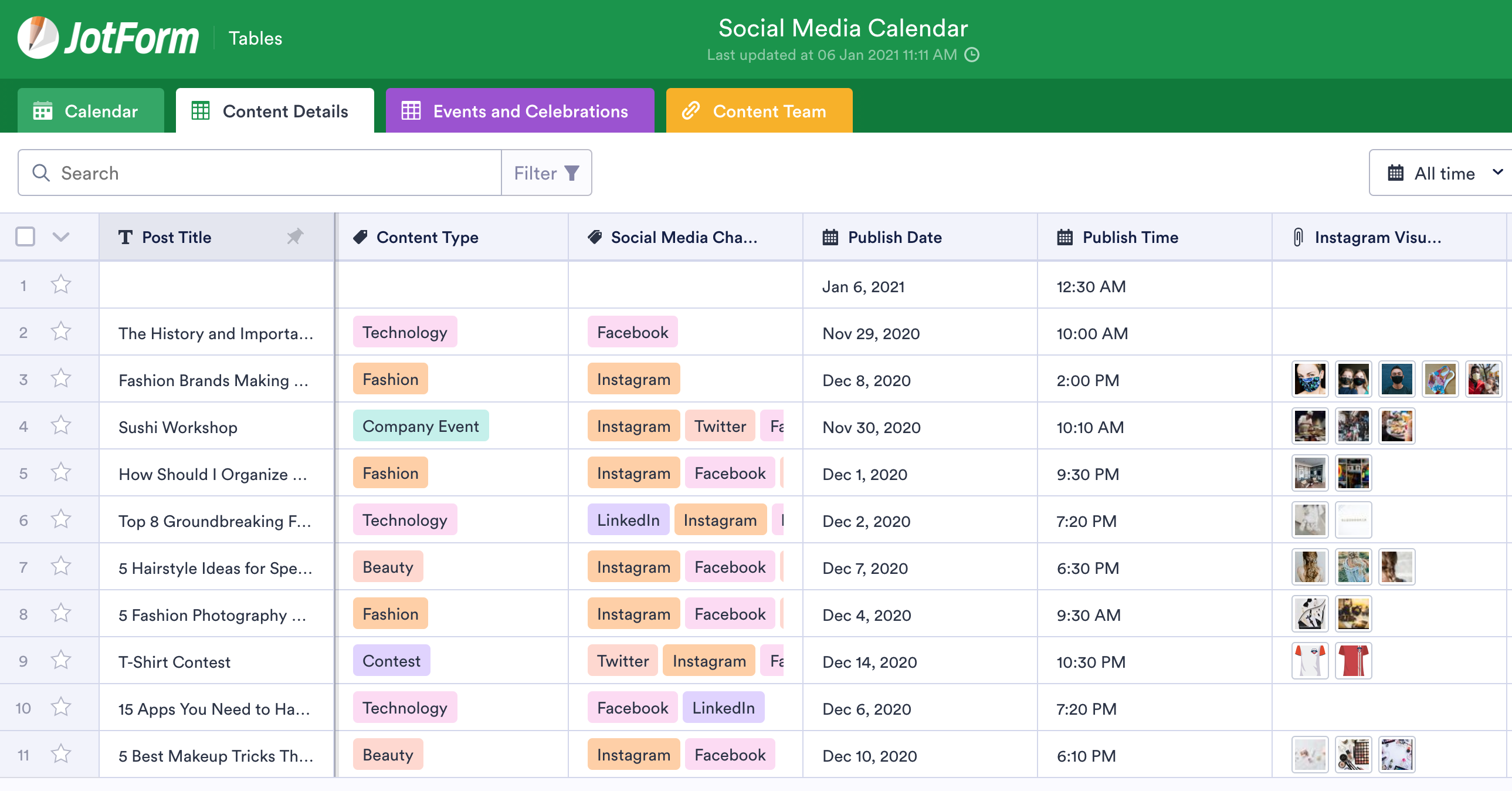
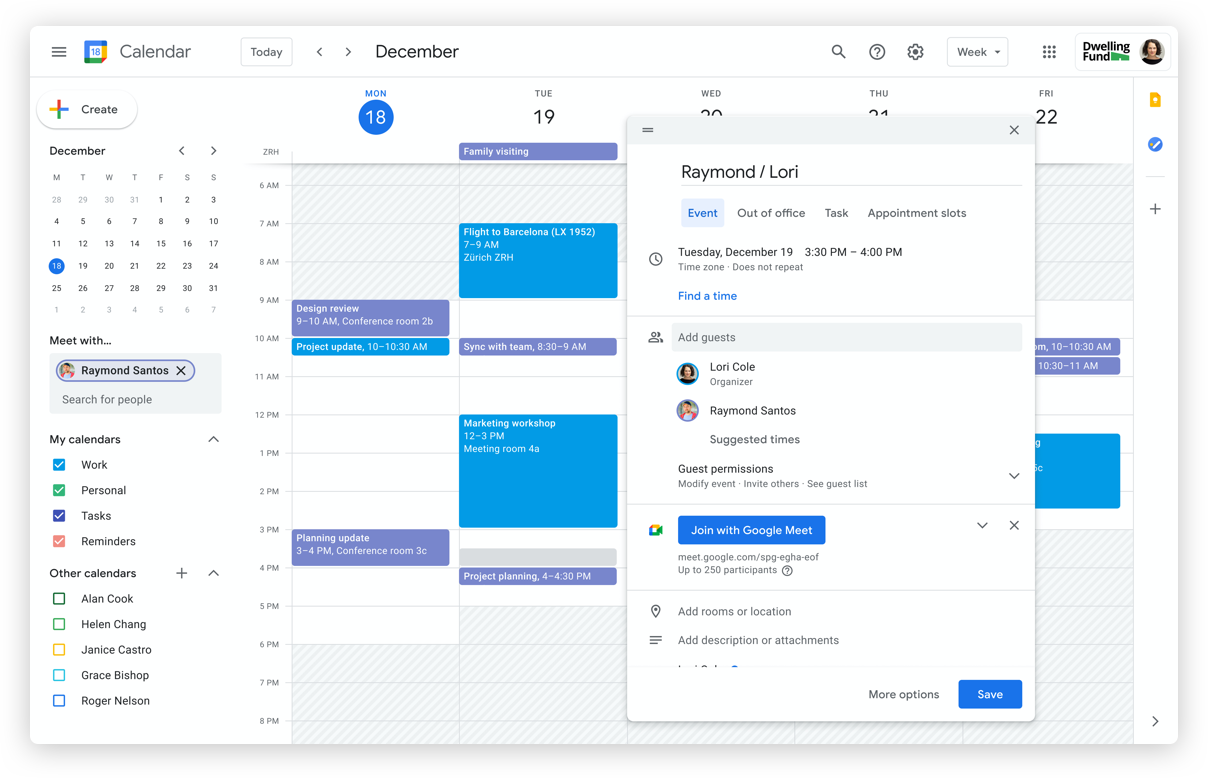
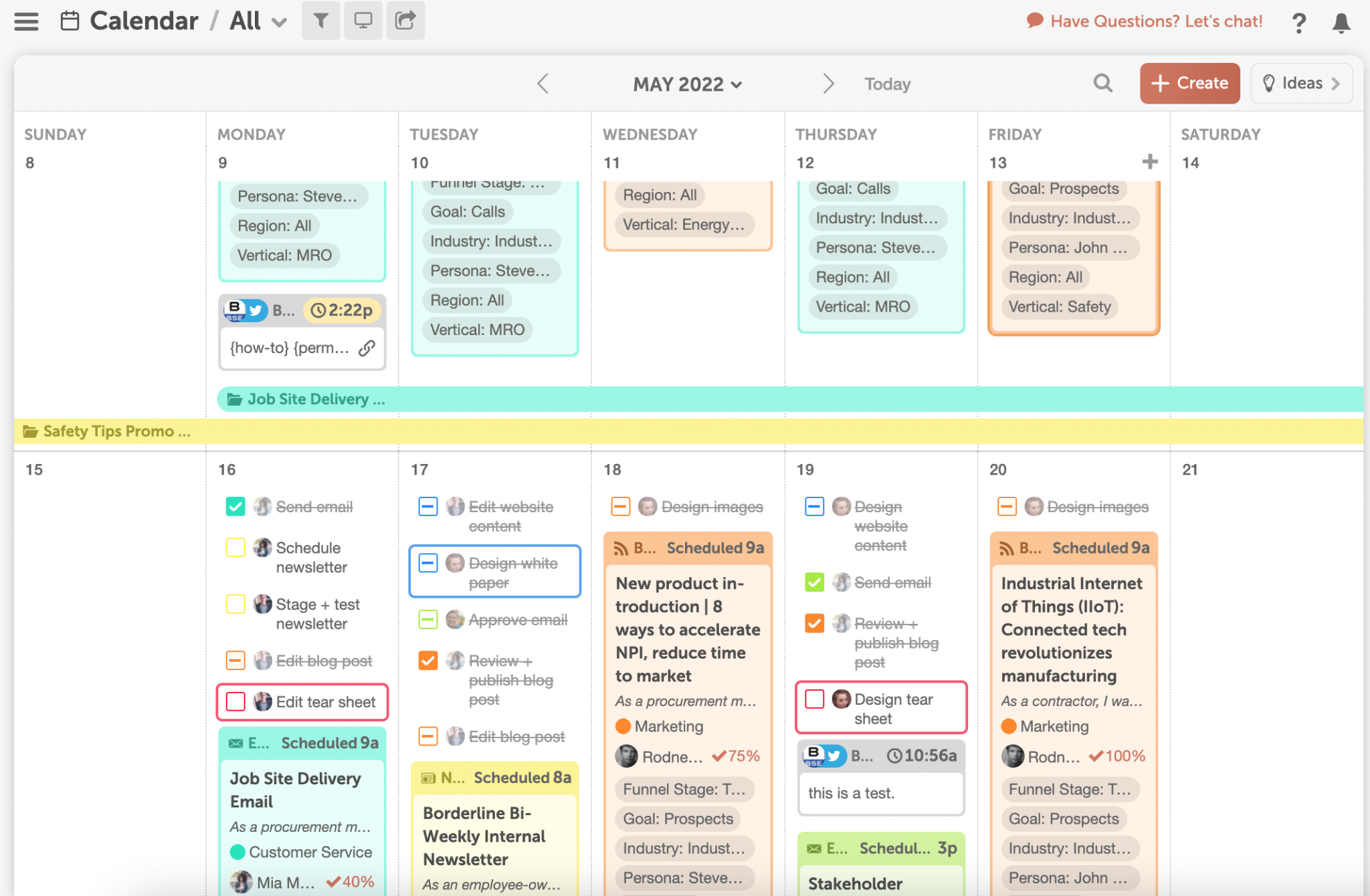



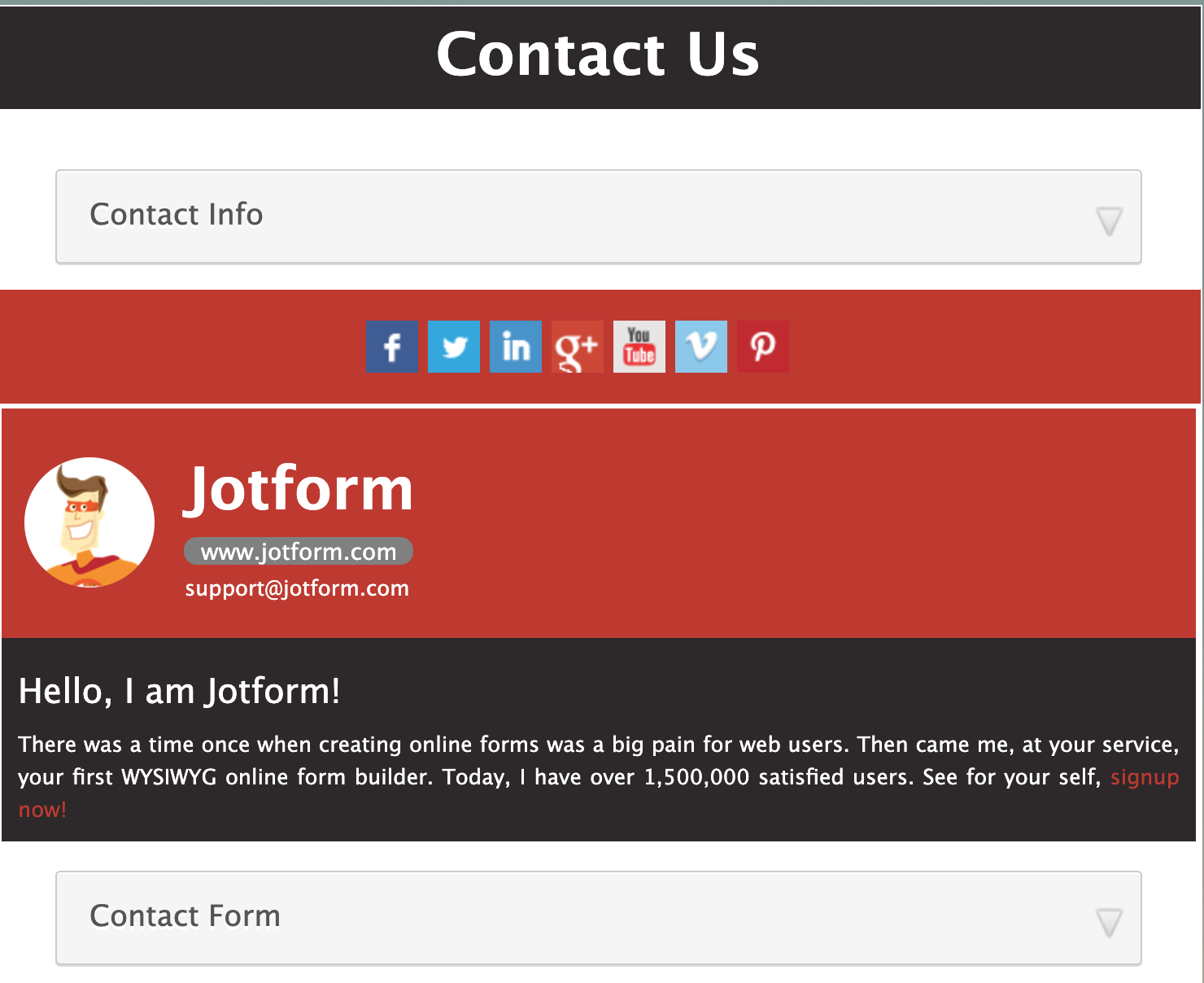


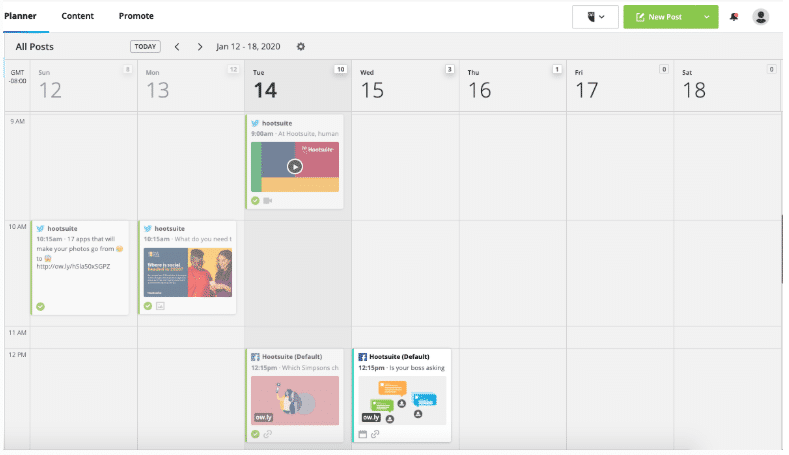
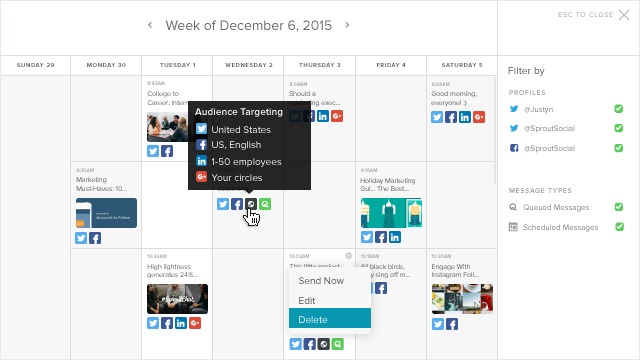
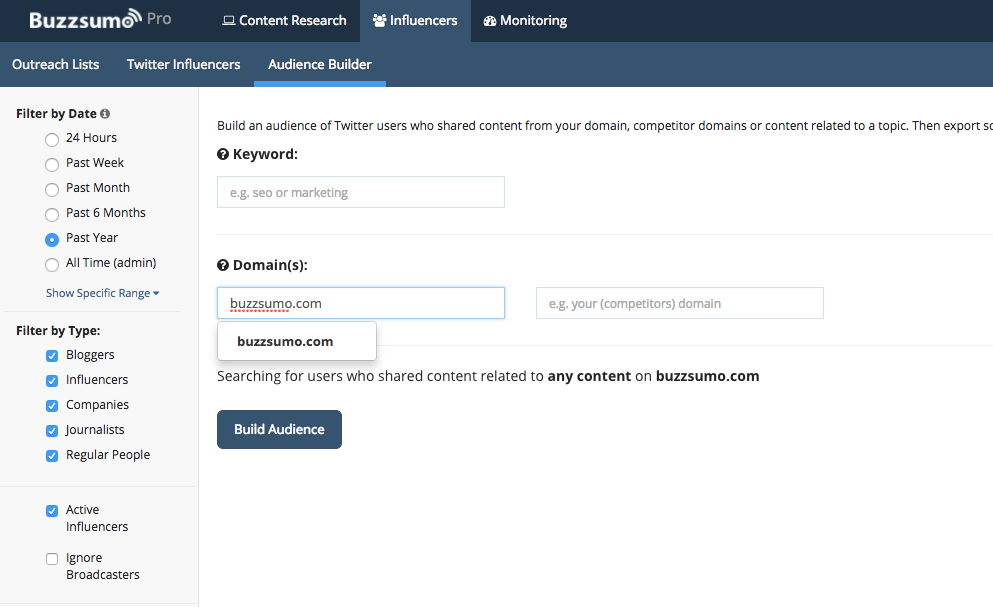
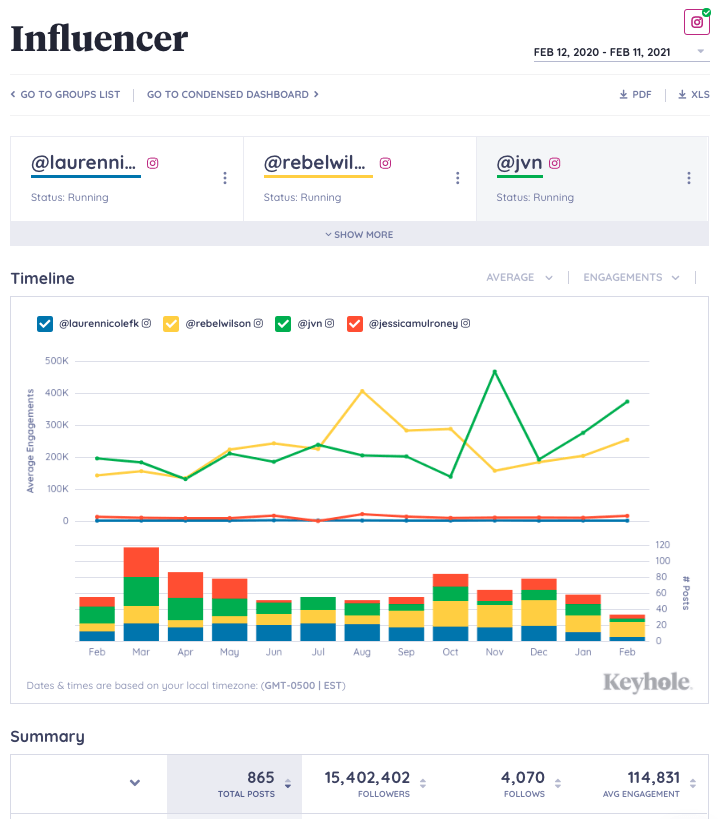









Send Comment: